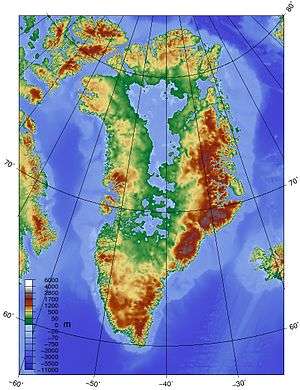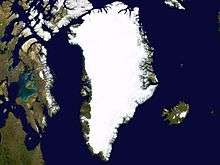Geography of Greenland
| Native name: Kalaallit Nunaat Grønland Greenland | |
|---|---|
 Outline map of Greenland with ice sheet depths. (Note that much of the area in green has permanent snow cover, but less than 10m (33ft) thick.) | |
| Geography | |
| Location | between the Arctic Ocean and the North Atlantic Ocean |
| Coordinates | 64°10′N 51°43′W / 64.167°N 51.717°W |
| Area | 2,166,086 km2 (836,330 sq mi) |
| Area rank | 1st |
| Coastline | 44,087 km (27,394.4 mi) |
| Highest elevation | 3,694 m (12,119 ft) |
| Highest point | Gunnbjørn |
| Administration | |
| Province |
|
| Largest settlement | Nuuk (Godthåb) (pop. 15,047) |
| Demographics | |
| Population | 56,344 (2007) |
| Pop. density | 0.026 /km2 (0.067 /sq mi) |
| Ethnic groups | 88% (Inuit,Inuit-Danish and Inuit-European mixed ), 12% Europeans, mostly Danish. |
Greenland is located between the Arctic Ocean and the North Atlantic Ocean, northeast of Canada and northwest of Iceland. The territory comprises the island of Greenland–the largest island in the world–and more than a hundred other smaller islands (see alphabetic list). As an island, Greenland has no land boundaries and 44,087 km of coastline. A sparse population is confined to small settlements along certain sectors of the coast. Greenland possesses the world's second largest ice sheet.
Greenland sits atop the Greenland plate, a subplate of the North American plate.[1][2] The Greenland craton is made up of some of the oldest rocks on the face of the earth. The Isua greenstone belt in southwestern Greenland contains the oldest known rocks on Earth, dated at 3.7–3.8 billion years old.[3]
The vegetation is generally sparse, with the only patch of forested land being found in Nanortalik Municipality in the extreme south near Cape Farewell.
The climate is arctic to subarctic, with cool summers and cold winters. The terrain is mostly a flat but gradually sloping icecap that covers all land except for a narrow, mountainous, barren, rocky coast. The lowest elevation is sea level and the highest elevation is the summit of Gunnbjørn Fjeld, the highest point in the Arctic at 3,694 meters (12,119 ft). The northernmost point of the Island of Greenland is Cape Morris Jesup, discovered by Admiral Robert Peary in 1909. Natural resources include zinc, lead, iron ore, coal, molybdenum, gold, platinum, uranium, hydropower and fish.
Area
total: 2,166,086 km²
land: 2,166,086 km² (410,449 km² ice-free, 1,755,637 km² ice-covered)
Maritime claims:
territorial sea: 3 nautical miles (5.6 km; 3.5 mi)
exclusive fishing zone: 200 nautical miles (370.4 km; 230.2 mi)
Land use
arable land:
approximately 0% ; some land is used to grow silage.
permanent crops:
approximately 0%
other:
100% (2012 est.)
Total population 56,000 inhabitants of whom ca. 15,000 live in the capital Nuuk.
Natural hazards
Continuous ice sheet covers 84% of the country; the rest is permafrost.
Environment – current issues
Protection of the Arctic environment, climate change, pollution of the food chain, excessive hunting [4] of endangered species (walrus, polar bears, narwhal, beluga whale and several sea birds).
Climate




The Greenland ice sheet is 3 kilometers (1.9 mi) thick and broad enough to blanket an area the size of Mexico. The ice is so massive that its weight presses the bedrock of Greenland below sea level and is so all-concealing that not until recently did scientists discover Greenland's Grand Canyon or the possibility that Greenland might actually be three islands.[5]
If the ice melted, the interior bedrock below sea level would be covered by water. It is not clear whether this water would be at sea level or a lake above sea level. If it would be at sea level it could connect to the sea at Ilulissat Icefjord, in Baffin Bay and near Nordostrundingen, creating three large islands.[6] But it is most likely that it would be a lake with one drain.
It is thought that before the Ice Age Greenland had mountainous edges, and a lowland (and probably very dry) center which drained to the sea by one big river flowing out westwards past where Disko Island is now.
There is concern about sea level rise caused by ice loss (melt and glaciers falling into the sea) on Greenland. Between 1997 and 2003 ice loss was 68–92 km3/a (16–22 cu mi/a), compared to about 60 km3/a (14 cu mi/a) for 1993/4-1998/9. Half of the increase was from higher summer melting, with the rest caused by velocities of some glaciers exceeding those needed to balance upstream snow accumulation (Krabill et al., L24402, GRL 2004). A complete loss of ice on Greenland would cause a sea level rise of as much as 6.40 meters (21.0 ft).
Researchers at NASA's Jet Propulsion Laboratory and the University of Kansas reported in February 2006 that the glaciers are melting twice as fast as they were five years ago. By 2005, Greenland was beginning to lose more ice volume than anyone expected – an annual loss of up to 52 cubic miles or 217 cubic kilometres per year, according to more recent satellite gravity measurements released by JPL. The increased ice loss may be partially offset by increased snow accumulation due to increased precipitation.
Between 1991 and 2006, monitoring of the weather at one location (Swiss Camp) found that the average winter temperature had risen almost 10 °F (5.6 °C).
Recently, Greenland's three largest outlet glaciers have started moving faster, satellite data show. These are the Jakobshavn Isbræ at Ilulissat on the western edge of Greenland, and the Kangerdlugssuaq and Helheim glaciers on the eastern edge of Greenland. The two latter accelerated greatly during the years 2004–2005, but returned to pre-2004 velocities in 2006.[7] The accelerating ice flow has been accompanied by a dramatic increase in seismic activity. In March 2006, researchers at Harvard University and the Lamont-Doherty Earth Observatory at Columbia University reported that the glaciers now generate swarms of earthquakes up to magnitude 5.0.[5]
The retreat of Greenland's ice is revealing islands that were thought to be part of the mainland. In September 2005 Dennis Schmitt discovered an island 400 miles (644 km) north of the Arctic Circle in eastern Greenland which he named Uunartoq Qeqertaq, Inuit for "warming island".[8]
Extreme points
This is a list of the extreme points of Greenland, the points that are farther north, south, east or west than any other location.
Territory of Greenland
- Northernmost Point — Kaffeklubben Island (83°40'N) – the northernmost permanent land in the world. There are also some shifting gravel bars that lie north of Kaffeklubben, the most famous being Oodaaq.
- Southernmost point — unnamed islet 2.3 km south of Cape Farewell, Egger Island (59°44'N)
- Westernmost point — Nordvestø, Carey Islands (73°10'W)
- Easternmost point — Nordostrundingen, Greenland (11°19'W)
- Highest point — Gunnbjørn Fjeld, 3,694 meters (12,119 ft).
Island of Greenland
- Northernmost point — Cape Morris Jesup (83°39'N)
- Southernmost point — Peninsula near Nanortalik
- Westernmost point — Cape Alexander (73°08'W)
- Easternmost point — Nordostrundingen, Greenland (11°19'W)
- Highest point — Gunnbjørn Fjeld, 3,694 meters (12,119 ft).
Towns
Greenland has 18 towns – settlements with more than 500 inhabitants. Nuuk is the largest town – and the capital – with roughly one third of the country's urban population. Sisimiut with approximately 5,500 inhabitants is the second largest town, while Ilulissat is number three with ca. 5,000 inhabitants.
History of Exploration
See Cartographic expeditions to Greenland
Gallery

 An enlargeable satellite composite image of Greenland
An enlargeable satellite composite image of Greenland Sermeq Kujatdlek Glacier on Greenland's west coast.
Sermeq Kujatdlek Glacier on Greenland's west coast. Nunatak mountains on Greenland's east coast.
Nunatak mountains on Greenland's east coast. A polar bear on Greenland's eastern coast.
A polar bear on Greenland's eastern coast. Image showing small glaciers spilling into a mostly dry valley in western Greenland.
Image showing small glaciers spilling into a mostly dry valley in western Greenland. View of deep canyons, or fjords, along the coast of north-western Greenland.
View of deep canyons, or fjords, along the coast of north-western Greenland.- Mountains in southern Greenland, as seen from an altitude of approximately 34,000 feet
See also
References
- ↑
 Chisholm, Hugh, ed. (1911). "Baffin Bay and Baffin Land". Encyclopædia Britannica (11th ed.). Cambridge University Press.
Chisholm, Hugh, ed. (1911). "Baffin Bay and Baffin Land". Encyclopædia Britannica (11th ed.). Cambridge University Press. - ↑ "BAFFIN BAY" (PDF). Indian and Northern Affairs Canada. Retrieved 2009-10-04.
- ↑ Appel, Peter W.U., Hugh R. Rollinson, and Jacques L.R. Touret. (2001) "Remnants of an Early Archaean (>3.75 Ga) sea-floor, hydrothermal system in the Isua Greenstone Belt." Precambrian Research, 112.1–2, 15 November, pp. 27–49.
- ↑
- 1 2 Los Angeles Times, June 25, 2006, "Greenland's Ice Sheet Is Slip-Sliding Away"
- ↑ Is the world’s fastest-moving glacier set to speed up even more?
- ↑ Rapid Changes in Ice Discharge from Greenland Outlet Glaciers – Howat et al., 10.1126/science.1138478 – Science
- ↑ The Warming of Greenland, New York Times, January 16, 2007
External links
| Wikimedia Commons has media related to Geography of Greenland. |
- www.geus.dk Geological map of Greenland from the Geological Survey of Denmark and Greenland ( GEUS).
- Times Atlas reviews Greenland map accuracy after climate change row – The Guardian, 22 September 2011

